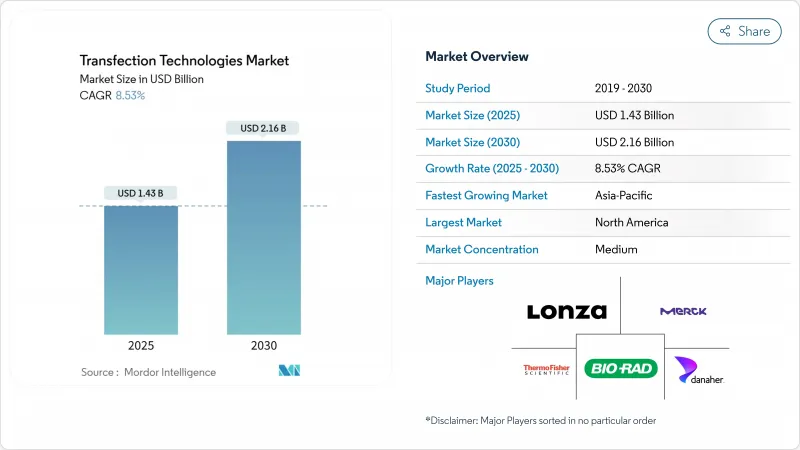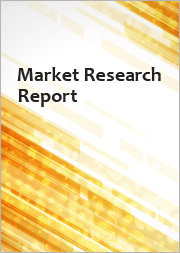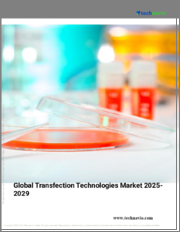
|
시장보고서
상품코드
1836640
트랜스펙션 기술 시장 : 점유율 분석, 산업 동향, 통계, 성장 예측(2025-2030년)Transfection Technologies - Market Share Analysis, Industry Trends & Statistics, Growth Forecasts (2025 - 2030) |
||||||
트랜스펙션 기술 시장 규모는 2025년에 14억 3,000만 달러, 예측 기간 중(2025-2030년) CAGR은 8.53%를 나타내고, 2030년에는 21억 6,000만 달러에 달할 것으로 예측됩니다.

이 궤적은 소규모 실험실 프로토콜에서 유전자 및 세포 치료 부문에서 요구하는 확장 가능한 cGMP 준수 플랫폼으로 빠르게 전환되고 있음을 반영합니다. DNA, RNA, 단백질의 1차 세포로의 고효율, 저독성 전달을 필요로 하는 37개의 FDA 승인 유전자 치료 제품에 의해 그 보급이 가속화되고 있습니다. 장비 제조업체는 전기천공, 마이크로플루이딕스, 지질 나노입자 워크플로우를 자동화하여 현재 2,000억 세포를 초과하는 상업적 배치 크기를 지원합니다. 톱 벤더는 mRNA 백신, 동종 CAR-T 요법 및 생체 내 CRISPR 제품의 검증 사이클을 단축하는 폐쇄 단일 사용 소모품으로 차별화를 도모하고 있습니다. 지역적으로 미국과 캐나다는 강력한 규제 및 제조 생태계를 유지하고 있지만, 싱가포르, 일본, 중국으로의 자본 유입은 아시아태평양의 생산 기지로의 재조정의 도래를 보여줍니다.
세계 트랜스펙션 기술 시장 동향과 통찰
만성 질환 증가
암, 신경질환, 유전성 혈액질환은 세계적으로 증가하고 있으며, 헬스케어 시스템은 유전자 도입 및 유전자 편집에 근거한 치료적 접근으로 향하고 있습니다. CAR-T 파이프라인만으로도 1차 T세포에서 생존율 85% 이상을 유지하면서 90%의 효율을 달성할 수 있는 형질감염 플랫폼이 필요하며, 이 임계값은 현재 최적화된 일렉트로포레이션 버퍼에 의해 달성되고 있습니다. 포커스 초음파 지원 CRISPR 전달은 바이러스 벡터 없이 정확한 뇌내 편집을 입증하고 새로운 치료 프론티어를 시사합니다. CASGEVY의 정가는 220만 달러로 비싸지만, 이는 생산 일정을 몇 주에서 며칠로 단축하는 첨단 장비에 대한 설비 투자를 정당화합니다.
세포 및 유전자 치료에 있어서의 연구개발의 확대
세계 임상 활동은 2024년에는 1,200건을 넘어 확장 가능하고 반복 가능한 트랜스펙션 프로토콜에 의존하는 상업적 상시를 위한 견고한 깔때기가 형성됩니다. 동종세포 은행에서는 한 번의 제조 공정으로 수백 명의 환자를 치료할 수 있어 수요가 확대되고 공정 분석 기술을 갖춘 폐쇄형 일렉트로포레이션 시스템에 대한 주목이 높아지고 있습니다. Lonza 사의 CASGEVY 제조 계약과 같은 장기 공급 계약은 플랫폼 제공업체가 R&D 추세를 다년간 수익원으로 바꾸는 방법을 보여줍니다.
장비의 높은 자본 비용
최첨단 전기천공(electroporation) 스키드 장비는 50만 달러를 초과하여, 많은 초기 단계 기업에게는 고급 자동화 기술이 접근 불가능한 수준에 있습니다. 연간 서비스 계약과 일회용 카트리지는 총 소유 비용을 증가시킵니다. 장비의 as-a-service 모델은 현재 그 지출을 다년간의 운영 예산에 분산시키고 있지만, 그 비중은 여전히 미미합니다. 수탁개발·제조조직은 부담을 경감하지만, 슬롯의 제약으로 IND의 신청이 반년 늦는 경우도 있습니다. 저렴한 레이저 조각에 의해 만들어진 미세 유체 칩은 부유 세포에서 90% 이상의 형질 감염 효율을 유지하면서 자본 비용을 줄일 가능성을 보여줍니다.
보고서에서 분석된 기타 촉진요인 및 억제요인
- 합성 생물학 워크플로우에 대한 수요 증가
- 정부의 바이오 주조 프로그램
- 기존 시약의 세포독성과 저효율성
부문 분석
키트 및 시약은 소모품의 경상 수익성과 신흥 용도를 위한 특수한 처방 요건을 반영하여 2024년 시장 점유율 56.35%로 지배적 지위를 유지했습니다. 그러나 2030년까지 연평균 복합 성장률(CAGR)은 9.22%로 장비가 가장 급성장하고 있습니다. 이는 세포 치료 제조에 있어서의 자동화의 필요성과 다양한 유형의 세포를 안정된 성능으로 취급할 수 있는 확장 가능한 플랫폼에 대한 요구에 의한 것입니다.
산업계의 구매자는 세포종 이상의 성능, MES 소프트웨어와의 통합, 검증된 세척 프로토콜로 플랫폼을 평가합니다. Thermo Fisher의 5L 다이너 드라이브 바이오리액터는 네온 전기천공 장치와 결합하여 공정 개발 시간을 27% 단축하는 엔드 투 엔드 솔루션을 형성합니다. 그 결과, 장치 하위 부문의 트랜스펙션 기술 시장 규모는 레거시 시약 라인보다 급속히 확대되어 2030년까지 4억 2,000만 달러를 획득할 것으로 예측됩니다.
지역별 분석
북미는 강력한 벤처 투자, 화학 제조 관리에 대한 기대를 명확히 하는 FDA 지침, 전문 CDMO 네트워크를 통해 2024년 매출의 38.86%를 유지했습니다. 이 지역은 mRNA 백신의 스케일 업에서 우위를 차지하고 있으며, 프로세스 엔지니어는 지질 나노 입자 제제를 감염 이외의 치료 페이로드에도 적용하는 것을 배웠습니다. 그럼에도 불구하고 노동력 부족과 높은 시설 간접비로 인해 운영자의 노출을 줄이는 조명이없는 제조 제품군에 대한 관심이 지속되고 있습니다.
아시아태평양은 가장 급성장하는 지역으로 CAGR 10.23%로 확대되고 있습니다. 싱가포르의 세포치료시설은 GMP 스위트를 보조금으로 제공하고 있으며, 일본의 문샷 연구개발 프로그램은 인공 다능성 줄기세포의 높은 전달률을 확보하는 일렉트로포레이션 연구를 보조하고 있습니다. 중국의 합성 생물학 공원은 월 1,000개의 균주 설계 용량을 확보하여 지질-나노입자 시약에 대한 대량 조달 계약을 추진하고 있습니다.
유럽은 성숙한 분야이지만 신중한 확장을 계속하고 있습니다. 독일은 백신 붐으로 길러진 메신저 RNA 제조의 전문 지식을 살려 희귀질환 치료제로 전환하고 있으며, 유전자 재조합 세포에 관한 EMA의 지침이 회원국 간의 품질에 대한 기대의 조화를 도모하고 있습니다. 엄격한 유전자 변형 작물 규제가 농업에 대한 응용을 늦추고 있지만, 매력적인 연구 자금이 규제 마찰을 다소 완화하고 있습니다.
기타 혜택 :
- 엑셀 형식 시장 예측(ME) 시트
- 3개월간의 애널리스트 서포트
목차
제1장 서론
- 조사의 전제조건과 시장 정의
- 조사 범위
제2장 조사 방법
제3장 주요 요약
제4장 시장 상황
- 시장 개요
- 시장 성장 촉진요인
- 만성 질환 증가
- 세포·유전자 기반의 치료법의 연구 개발 확대
- 합성 생물학 워크플로우에 대한 수요 증가
- 정부의 바이오 파운드리 프로그램
- mRNA 백신의 생산 확대는 고처리량(transfection) 기술 필요
- 제조 공정의 자동화와 표준화
- 시장 성장 억제요인
- 높은 자본 비용
- 기존 시약의 세포 독성 및 낮은 효율성
- 복잡한 cGMP 플라스미드 공급 체인의 병목
- 유전자 편집 페이로드에 대한 규제 상의 조사
- 규제 상황
- Porter's Five Forces 분석
- 신규 참가업체의 위협
- 구매자의 협상력
- 공급기업의 협상력
- 대체품의 위협
- 경쟁 기업간 경쟁 관계의 강도
제5장 시장 규모 및 성장 예측(금액)
- 제품 유형별
- 키트 및 시약
- 기구
- 액세서리
- 용도별
- 생물의학 연구
- 치료 전달
- 단백질 생산
- 합성 생물학과 유전체 공학
- 기타 용도
- 최종 사용자별
- 학술기관 및 연구기관
- 제약 및 바이오테크놀러지 기업
- CRO 및 CMO
- 병원·임상 연구소
- 지역별
- 북미
- 미국
- 캐나다
- 멕시코
- 유럽
- 독일
- 영국
- 프랑스
- 이탈리아
- 스페인
- 기타 유럽
- 아시아태평양
- 중국
- 일본
- 인도
- 호주
- 한국
- 기타 아시아태평양
- 중동 및 아프리카
- GCC
- 남아프리카
- 기타 중동 및 아프리카
- 남미
- 브라질
- 아르헨티나
- 기타 남미
- 북미
제6장 경쟁 구도
- 시장 집중도
- 시장 점유율 분석
- 기업 프로파일
- Thermo Fisher Scientific
- Lonza Group
- Qiagen NV
- Merck KGaA
- Bio-Rad Laboratories
- Promega Corporation
- Agilent Technologies
- MaxCyte Inc.
- Altogen Biosystems
- Polyplus-transfection SA
- SignaGen Laboratories
- Mirus Bio LLC
- Horizon Discovery(PerkinElmer)
- Takara Bio Inc.
- Precision NanoSystems
- OriGene Technologies
- Lipocalyx GmbH
- InvivoGen
제7장 시장 기회와 전망
SHW 25.10.28The Transfection Technologies Market size is estimated at USD 1.43 billion in 2025, and is expected to reach USD 2.16 billion by 2030, at a CAGR of 8.53% during the forecast period (2025-2030).

This trajectory reflects a rapid pivot from small-scale laboratory protocols toward scalable, cGMP-compliant platforms demanded by the gene and cell therapy sector. Uptake is paced by 37 FDA-approved gene therapy products that require high-efficiency, low-toxicity delivery of DNA, RNA, or protein cargos into primary cells. Instrument makers are automating electroporation, microfluidics, and lipid-nanoparticle workflows to satisfy commercial batch sizes that now exceed 200 billion cells. Top vendors differentiate through closed, single-use consumables that shorten validation cycles for mRNA vaccines, allogeneic CAR-T therapies, and in vivo CRISPR products. Regionally, United States and Canada maintain strong regulatory and manufacturing ecosystems, yet capital flows into Singapore, Japan, and China indicate a coming rebalance toward Asia-Pacific production hubs.
Global Transfection Technologies Market Trends and Insights
Rising Incidence of Chronic Diseases
Cancer, neurological disorders, and inherited hematologic conditions are rising worldwide, pushing healthcare systems toward curative approaches based on gene transfer and genome editing. CAR-T pipelines alone require transfection platforms capable of 90% efficiency in primary T cells while maintaining >=85% viability, a threshold now achieved with optimized electroporation buffers. Focused ultrasound-assisted CRISPR delivery is demonstrating precise in-brain editing without viral vectors, signalling new therapeutic frontiers. High treatment prices-CASGEVY lists at USD 2.2 million-justify capital investment in advanced instruments that compress production timelines from weeks to days.
Expanding R&D in Cell and Gene-Based Therapies
Global clinical activity exceeded 1,200 active trials in 2024, creating a robust funnel for commercial launches that rely on scalable, repeatable transfection protocols. Allogeneic cell banks magnify demand because a single manufacturing run can treat hundreds of patients, intensifying the focus on closed electroporation systems with process analytical technology. Long-term supply contracts-such as Lonza's agreement to produce CASGEVY-illustrate how platform providers convert R&D momentum into multi-year revenue streams.
High Capital Cost of Instruments
State-of-the-art electroporation skids exceed USD 500,000, placing advanced automation out of reach for many early-stage firms. Annual service contracts and single-use cartridges amplify total cost of ownership. Equipment-as-a-service models now spread that outlay over multi-year operating budgets, yet uptake remains modest. Contract development and manufacturing organizations relieve the burden, but slot constraints can delay IND filings by six months. Microfluidic chips fabricated through inexpensive laser engraving show promise to undercut capital costs while sustaining >=90% transfection efficiency in suspension cells.
Other drivers and restraints analyzed in the detailed report include:
- Growing Demand for Synthetic Biology Workflows
- Government Bio-foundry Programmes
- Cytotoxicity and Low Efficiency of Legacy Reagents
For complete list of drivers and restraints, kindly check the Table Of Contents.
Segment Analysis
Kits and reagents maintained their dominant position with 56.35% market share in 2024, reflecting the recurring revenue nature of consumables and the specialized formulation requirements for emerging applications. However, instruments represent the fastest-growing segment at 9.22% CAGR through 2030, driven by automation imperatives in cell therapy manufacturing and the need for scalable platforms that can handle diverse cell types with consistent performance.
Industrial buyers evaluate platforms on cross-cell-type performance, integration with MES software, and validated cleaning protocols. Thermo Fisher's 5 L DynaDrive bioreactor pairs with its neon electroporation device to form an end-to-end solution that trims process development time by 27%. As a result, the transfection technologies market size for instrument sub-segments is projected to expand faster than legacy reagent lines, capturing an incremental USD 420 million by 2030.
The Transfection Technologies Market Report is Segmented by Product Type (Kits and Reagents, Instruments, and Accessories), Application (Biomedical Research, Therapeutic Delivery, Protein Production, and More), End User (Academic and Research Institutes, Pharmaceutical and Biotechnology Companies and More) and Geography (North America, Europe, Asia Pacific and More). The Market Forecasts are Provided in Terms of Value (USD).
Geography Analysis
North America retained 38.86% of 2024 revenue thanks to strong venture investment, FDA guidance that clarifies chemistry-manufacturing-control expectations, and a network of specialized CDMOs. The region's dominance in mRNA vaccine scale-up taught process engineers to apply lipid-nanoparticle formulations to therapeutic payloads beyond infectious disease. Nevertheless, labor shortages and high facility overheads sustain interest in lights-out manufacturing suites that reduce operator exposure.
Asia-Pacific is the fastest-growing territory, expanding at a 10.23% CAGR. Singapore's Cell Therapy Facility offers subsidized GMP suites, while Japan's Moonshot R&D program subsidizes electroporation studies that ensure higher delivery rates in induced pluripotent stem cells. China's synthetic-biology parks push for 1,000-strain per month design capacity, driving bulk procurement agreements for lipid-nanoparticle reagents.
Europe remains a mature but cautiously expanding arena. Germany leverages messenger-RNA manufacturing expertise from its vaccine boom to pivot toward rare-disease therapeutics, while EMA guidance on genetically modified cells harmonizes quality expectations across member states. Stringent GMO regulations slow agricultural applications, yet attractive research funding offsets some regulatory friction.
- Thermo Fisher Scientific
- Lonza Group
- QIAGEN
- Merck
- Bio-Rad Laboratories
- Promega
- Agilent Technologies
- MaxCyte
- Altogen Biosystems
- Polyplus-transfection
- SignaGen Laboratories
- Mirus Bio
- Horizon Discovery (PerkinElmer)
- Takara Bio
- Precision NanoSystems
- OriGene Technologies
- Lipocalyx GmbH
- InvivoGen
Additional Benefits:
- The market estimate (ME) sheet in Excel format
- 3 months of analyst support
TABLE OF CONTENTS
1 Introduction
- 1.1 Study Assumptions & Market Definition
- 1.2 Scope of the Study
2 Research Methodology
3 Executive Summary
4 Market Landscape
- 4.1 Market Overview
- 4.2 Market Drivers
- 4.2.1 Rising incidence of chronic diseases
- 4.2.2 Expanding R&D in cell- & gene-based therapies
- 4.2.3 Growing demand for synthetic biology workflows
- 4.2.4 Government bio-foundry programmes
- 4.2.5 mRNA-vaccine scale-up needs high-throughput transfection
- 4.2.6 Automation and standardization of manufacturing processes
- 4.3 Market Restraints
- 4.3.1 High capital cost of instruments
- 4.3.2 Cytotoxicity and low efficiency of legacy reagents
- 4.3.3 Complex cGMP plasmid supply chain bottlenecks
- 4.3.4 Regulatory scrutiny on gene-editing payloads
- 4.4 Regulatory Landscape
- 4.5 Porter's Five Forces Analysis
- 4.5.1 Threat of New Entrants
- 4.5.2 Bargaining Power of Buyers
- 4.5.3 Bargaining Power of Suppliers
- 4.5.4 Threat of Substitutes
- 4.5.5 Intensity of Competitive Rivalry
5 Market Size & Growth Forecasts (Value)
- 5.1 By Product Type
- 5.1.1 Kits and Reagents
- 5.1.2 Instruments
- 5.1.3 Accessories
- 5.2 By Application
- 5.2.1 Biomedical Research
- 5.2.2 Therapeutic Delivery
- 5.2.3 Protein Production
- 5.2.4 Synthetic Biology and Genome Engineering
- 5.2.5 Other Applications
- 5.3 By End User
- 5.3.1 Academic and Research Institutes
- 5.3.2 Pharmaceutical and Biotechnology Companies
- 5.3.3 CROs and CMOs
- 5.3.4 Hospitals and Clinical Laboratories
- 5.4 By Geography
- 5.4.1 North America
- 5.4.1.1 United States
- 5.4.1.2 Canada
- 5.4.1.3 Mexico
- 5.4.2 Europe
- 5.4.2.1 Germany
- 5.4.2.2 United Kingdom
- 5.4.2.3 France
- 5.4.2.4 Italy
- 5.4.2.5 Spain
- 5.4.2.6 Rest of Europe
- 5.4.3 Asia Pacific
- 5.4.3.1 China
- 5.4.3.2 Japan
- 5.4.3.3 India
- 5.4.3.4 Australia
- 5.4.3.5 South Korea
- 5.4.3.6 Rest of Asia Pacific
- 5.4.4 Middle East and Africa
- 5.4.4.1 GCC
- 5.4.4.2 South Africa
- 5.4.4.3 Rest of Middle East and Africa
- 5.4.5 South America
- 5.4.5.1 Brazil
- 5.4.5.2 Argentina
- 5.4.5.3 Rest of South America
- 5.4.1 North America
6 Competitive Landscape
- 6.1 Market Concentration
- 6.2 Market Share Analysis
- 6.3 Company Profiles (includes Global level Overview, Market level overview, Core Segments, Financials as available, Strategic Information, Market Rank/Share for key companies, Products & Services, and Recent Developments)
- 6.3.1 Thermo Fisher Scientific
- 6.3.2 Lonza Group
- 6.3.3 Qiagen NV
- 6.3.4 Merck KGaA
- 6.3.5 Bio-Rad Laboratories
- 6.3.6 Promega Corporation
- 6.3.7 Agilent Technologies
- 6.3.8 MaxCyte Inc.
- 6.3.9 Altogen Biosystems
- 6.3.10 Polyplus-transfection SA
- 6.3.11 SignaGen Laboratories
- 6.3.12 Mirus Bio LLC
- 6.3.13 Horizon Discovery (PerkinElmer)
- 6.3.14 Takara Bio Inc.
- 6.3.15 Precision NanoSystems
- 6.3.16 OriGene Technologies
- 6.3.17 Lipocalyx GmbH
- 6.3.18 InvivoGen
7 Market Opportunities & Future Outlook
- 7.1 White-space & Unmet-need Assessment

















